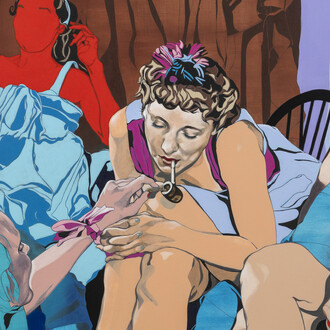From 4 October 2025 to 22 March 2026, museum van Bommel van Dam in Venlo presents Fantastic beings. This international group exhibition brings together mostly recent works by established and emerging artists. Mythical figures and age-old stories are their source of inspiration. Through fabulous creatures rendered in textiles, drawings, ceramics, paintings, videos and installations, they reflect on current themes such as identity, culture and social relations. What makes this exhibition unique is the way it connects the old and the new: myths may be stories from the past, but at the same time they are living traditions. They continue to evolve, inspiring new generations.
Participating artists include Jamel Armand, afra eisma, Alejandro Galván, Camille Henrot, Susanna Inglada, Hella Jongerius, Wouter Osterholt, Tanja Ritterbex, RojoNegro, Buhlebezwe Siwani, María Sosa, Nina van de Ven, Theresa Weber and Müge Yilmaz.
A journey through cultures and eras
Fantastic beings presents works by contemporary artists from the Netherlands, Germany, France, Spain, Turkey, South Africa and Mexico. All of them draw from the rich tradition of mythology and fantasy in art - a tradition that has existed for thousands of years, from the prehistoric cave paintings of Lascaux and the richly decorated Egyptian temples to the Renaissance masters and post-war CoBrA artists such as Karel Appel. For example, Jamel Armand explores relationships with unknown ancestors through the figures in his paintings - a tribute to a culture with which he still feels connected despite a generational rupture. Afra Eisma chooses wondrous creatures as guides, reminiscent of protectors and messengers in ancient stories. And Müge Yilmaz and Buhlebezwe Siwani create works that explore the spiritual and ritual aspects of myths.
Museum director Rieke Righolt: "In a world where technology and globalization blur the boundaries between cultures, the mythical figures and fabulous beings from ancient stories offer a way to connect with the past while also discovering new meanings."
Contemporary reinterpretations
Upon entering Fantastic beings, visitors are confronted by a monumental textile head: Medusa (2022). This work by Spanish artist Susanna Inglada (1983) deviates strikingly from the familiar monster with snake hair from Greek mythology. Tears stream from her eyes. Inglada portrays the often-overlooked side of the story: Medusa was raped by the sea god Poseidon, after which Athena, out of jealousy, transformed her into a monster. "This monumental work offers a new, female perspective on a myth that for centuries was mainly told by men," says curator James Hannan.
Equally impressive is the more than five-meter-wide installation Los monstruos no vivian aqui (2020) by Mexican artist María Sosa (1985). Painted batik cloth depicts fantastical creatures derived from medieval European world maps. Unknown regions on these maps were often marked with the phrase "here be monsters." The irony: European explorers did not encounter monsters in the Americas - instead, they themselves had a devastating impact on the indigenous peoples.
One of the highlights of Fantastic beings is grosse fatigue (2013), a groundbreaking film by French artist Camille Henrot (1978). For this work, Henrot received the prestigious Silver Lion at the 55th Venice Biennale. The film brings together creation myths from different civilizations into an overwhelming mix of scientific discovery and mythology. Spoken word and rapid image sequences bombard the viewer with knowledge as a stream of associations.
With Angry animals (2024) by Dutch designer Hella Jongerius (1963), museum van Bommel van Dam also presents a Dutch premiere: after Berlin, New York and Paris, this new series of ceramics will be shown in the Netherlands for the first time. Wild animals rarely have a voice - except in fairy tales. With heads contorted in rage and frustration, Jongerius gives expression to the suffering of our "silent partners." These objects, nearly unusable as functional ware, stand as a quiet resistance against human consumption.
An inspiration from the museum collection
A special role in the exhibition is played by a series of painted etchings from the 1980s, drawn from the museum's own collection. They were made by the Limburg-based artist Marianne van der Heijden (1922-1998). Over the years, Van der Heijden made a clear artistic shift: from religiously inspired art to critical reflections on belief. One example is Aanbidding van het beest (Adoration of the beast, 1984). At first glance it seems to reference ritual worship - yet the central figure is not a saint but a mysterious, even menacing being. In Van der Heijden's modern-looking fantastic creatures, her personal search for identity and faith is reflected.
A mysterious autumn in Venlo
Alongside Fantastic beings, the exhibition Mysterious universe - Eugène Brands / Gabriel Lester will also be on view at museum van Bommel van Dam this autumn, from 6 September 2025 to 4 January 2026. The exhibition explores the cosmic fascination of CoBrA artist Eugène Brands (1913-2002), presented in an immersive setting by contemporary artist and inventor Gabriel Lester (1972). Both exhibitions share a fascination with the mysterious and the unknown: where Fantastic beings breathes new life into age-old myths, Mysterious universe explores the spiritual quest through the cosmos.










